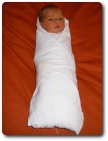Songs of Innocence and Experience Contents
Infant Sorrow - Imagery, symbolism and themes
Imagery and symbolism
Child – Infant Sorrow depends upon the reader's ideas about children. In Blake's time, new-born children could be seen as images of innocence, as in Infant Joy and in Cradle song. In the New Testament, Jesus says that the kingdom of God belongs to those who become like little children in their innocence and humility. Some Christians believed that children arrived fresh from God and thus retain their memory of him, an idea popular with the Romantics. Children, therefore, reflect the creativity and goodness of God. Followers of Rousseau would see a baby as naturally good and with an innate capacity to learn and grow, which society's demands crush and distort. (See Social / political background > The spirit of rebellion – politics.)
Other Christians in Blake's day believed that children came into the world as inheritors of original sin, so were ‘bad' until they had accepted personal salvation.
In this poem, the baby is seen as being filled with energy and instinctual life which can appear negative and destructive. However, according to Blake, these are positive attributes, so when he uses the term ‘fiend', it is not with its usual negative connotations.
Piping / cloud – This echoes the first poem in Songs of Innocence, but the infant's loud wailing, and knowing awareness of the negative aspects of the world here, is a world away from the innocence of the child in the cloud of Introduction (I). Similarly, there is a marked contrast to the ‘cloud' of the earthly body which contains an innocent soul in The Little Black Boy, and the fiendish contents of the cloud in Infant Sorrow.
 Bound – Tightly wrapping new-born babies in swaddling bands was common practice in Blake's day, as a means of giving a feeling of security and of helping the limbs to grow straight. Here Blake uses it as an image of parental oppression, against which any self-respecting individual would struggle. However, the child remains bound, as well as metaphorically confined by the strictures of its parents and society's expectations.
Bound – Tightly wrapping new-born babies in swaddling bands was common practice in Blake's day, as a means of giving a feeling of security and of helping the limbs to grow straight. Here Blake uses it as an image of parental oppression, against which any self-respecting individual would struggle. However, the child remains bound, as well as metaphorically confined by the strictures of its parents and society's expectations.
Investigating imagery and symbolism
- Make a list of other poems which use the image of snares and confinement, noting the literal and metaphorical meanings intended.
Themes
The perception of children
- Is the child born free and good, as Rousseau believed, or born sinful, as the Calvinist Christians believed?
- Or is this opposition the result of fallen human beings' inability to recognise that the capacity for good and evil both belong to humanity?
Blake's idea that a young child can clearly see God echoes the Romantic sensibility articulated by Wordsworth, that children had an existence in heaven before the commencement of their earthly life. See The world of the Romantics > Making sense of the intangible world > Seventeenth and eighteenth attitudes to childhood.
Blake saw the natural child as an image of the creative imagination which is the human being's spiritual core. He was concerned about the way in which social institutions such as the school system and parental authority crushed the capacity for imaginative vision. The child's capacity for happiness and play are expressions of this imagination. Any restraint can feel like an attempt to stifle creativity. This is the dilemma of the child who is necessarily subject to the parent's care.
How the human mind sees the nature of the world and its creator
According to Blake, ‘contraries' are facts about the world and about the nature of the creative force behind it. Heaven and Hell impinge on human experience. Thus the powerful energies within the world and the energies and instincts within human beings are necessary and beautiful. They become destructive when they are either denied or seen as the sole factor in life and experience. Blake's sub-theme is that vision based wholly on experience is as incomplete as the inadequacy of ignorant innocence.
Parental care and authority
In Blake's work, parents are often perceived as inhibiting and repressing their children. Their own fears and shame are communicated to the next generation through the parental desire to ‘protect' children from their desires. According to Blake, parents misuse ‘care' to repress children and bind them to themselves, rather than setting the children free by rejoicing in, and safeguarding, their capacity for play and imagination. Here, the response of the parents is equivocal but even the most neutral care has the potential for being perceived as restraint.
Related material
Scan and go

Scan on your mobile for direct link.